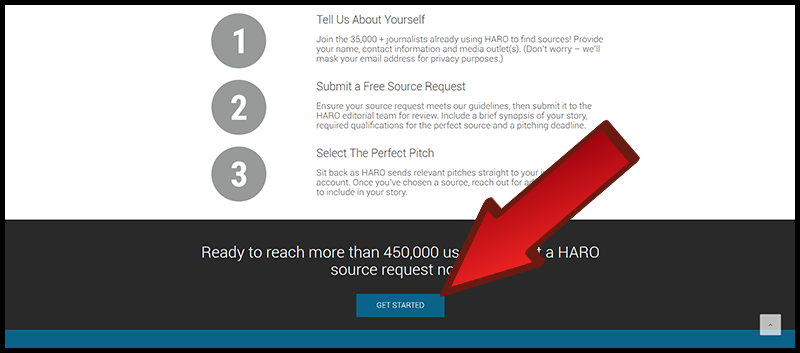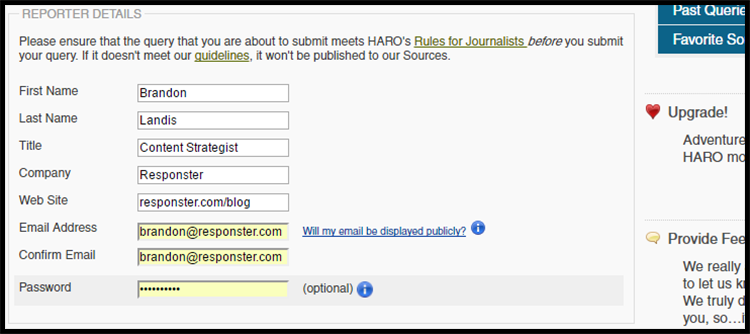At the time of writing this, our most popular blog post has had over 500 shares on social media since being published just two short months ago.
For our small blog, it was a clear runaway winner. While hard work and timely subject matter (it was about Snapchat, by the way) contributed to its success, one other factor undoubtedly helped the post stand out from anything else we’d written: I brought in outside sources that provided compelling cases studies, visual content, and real-life examples of what I was writing about, each adding to the content in a way I couldn’t have done on my own.
I found every single one using a nifty, free website called Help A Reporter Out, and it’s damn easy for you to do the same.
Here’s a basic rundown of how HARO works:
- You (a writer/blogger/journalist) submit a call for sources with a description of the piece you want to write
- Your request is emailed out in one of 3 daily mailings to HARO’s massive list
- Individuals and companies respond to the pitch, happy to provide content, case studies, or be interviewed in exchange for the potential exposure in your piece
- Writers choose which responses to incorporate into their project/post
- Your content gets shared more than usual because A) it’s backed up with concrete examples and B) multiple parties (you AND your sources) have a vested interest in sharing it
HARO works, and it’s popular. Seriously, even if you haven’t heard about it before today, everyone from your cousin the health food blogger to Forbes’ own writers are using it.
Below, I’ve written out exactly how to successfully use HARO to source some great content for your blog. (If you like this, be sure to subscribe so you catch Part 2 next week, in which we’ll dig into how you can use HARO from the other side: To get your company or personal brand coverage in other peoples’s publications.)
Alright, let’s get to it.
Getting Started:
Step 1) First things first, let’s head to HelpAReporter.com and make an account. For the purposes of this post, choose “I’m A Journalist” – don’t worry, you can create an “I‘m A Source” account with the same email later on.
They’ll show you a little page about how great they are (justifiably, they’re pretty awesome), but your next step is to just scroll down to the bottom of the page and click the “Get Started” button.
The page you hit next is where you’ll actually submit your request for sources.
I’m going to go through every field individually, with any best practices I’ve picked up for each one.
So that we’re working with a real example, I’m going to fill out the form with you. For the purposes of this post, let’s say I want to find people to interview for a post I’m writing on using Pinterest as a tool for eCommerce businesses. Let’s find us some Pinterest experts!
First things first, let’s drill into the top section.
Your Details
Drop in your full name and you’re off to a good start. For your title, you can just use your job title, or tweak it slightly for the purpose of relevancy to your query. For example, I might write “Content Strategist @ The Responster Blog” instead of “Chief Marketing Officer” or “Head of Customer Support”, etc.
In the company field, well, put down your company, silly.
Drop in a working email, as this is where responses to your request will be sent. If you choose to enter a password here, you’ll also be able to log in to the HARO site and get a look at your queries there as well (I usually skip this step, however).
Writing An Effective Request For Sources:
Query Details
Alright, so, when HARO sends out an email on your behalf to its email list, you want to standout among the list of stories in need of sources. Your best bet is to make it extremely clear what kind of responses and information you’re looking for.
This will also reduce the time you have to spend sorting through irrelevant responses and chasing down information.
Here’s some advice for a good pitch request:
Media Outlet: Let people know exactly where their content will appear. For example, I usually put down “The Responster Blog” here.
Note: You can check the ‘Keep me anonymous’ box to not have your media outlet displayed with your request. In some cases, this may help protect small publications against not getting many responses, or large ones from getting overflowed. So far, however, I haven’t trouble getting responses for The Responster Blog, and we’re small, so I wouldn’t worry about using anonymity.
Summary: It’s a bit misleading, but what HARO actually wants here is a headline for your query which sums up what it’s about.
In my Pinterest example, I might write “Looking for businesses & entrepreneurs who’ve used Pinterest to drive sales” or something similar.
Query: Time to hit ’em with the details. Here, you should describe your project and what specific information you’re interested in.
Requirements: In the requirements field, you can specify anything you do or do not want from a respondent. For example, you might tell them that you need to be able to verify their claims, or that you want your response a maximum length of 3 sentences, etc. In my example, above, you can see that I’ve requested visuals and let people know that submissions from anywhere in the world are welcome. Since many journalists use HARO to source local stories, it’s not a bad idea to let people know if you’re taking sources from anywhere in the world.
Target sharing date:
In the next step, you’ll set a “must submit by” date to specify when is the latest you want to receive pitches. HARO will generally send your pitch out a few days to a week before this time. That said, you can use the “Request Specific Date and Slot” using this link.
Personally, I’ve never requested my request be sent on a specific date, so I can’t speak to how well this works.
Note: HARO emails are sent out to their list with new story pitch requests 3 times per day. “Slot” refers to the morning, afternoon, and evening email blasts on a given date.
Targeting & Deadline
When HARO sends out its emails, they generally contain roughly 25-50 different story requests, so they segment them into categories to help sources find story requests that are most relevant to them.
Choose the best category and subcategory for your story. Most of us will likely be under the business, tech, or media umbrellas.
Next, set a deadline for the latest date you’ll accept pitches. Obviously, people can still respond to the email containing your pitch after that date if they want to, but if you set this date well in advance of when you want to actually write and publish a post, you’ll give yourself plenty of time to receive the bulk of your responses in plenty of time to make it into your project.
I’m gonna level with y’all: I’ve never used the “Urgent” box either, so I can’t say just how many carrier pigeons they send out on your behalf if you tick it, but it might be worth using in a pinch.
Once your pitch goes out in one of HARO’s daily mailings, you’ll receive an email letting you know. Depending on how specific you’ve been in your request, how interesting it is, and what your publication is, you’ll see a variance in the number of responses you receive.
All 3 times I’ve used HARO to source a story for our blog, I’ve hardly gotten any response at first and thought “Oh darn, no one wants to participate!” but then, slowly but surely, they trickle in. People read emails at different times, but I’ve noticed between 5 and 15 responses coming in during the first 3 days or so each time. Of these, at least one (and usually more) are going to provide you with the spark and details you need to bring something special to your post.
Everything will come to the email address you used to submit your pitch request, so you don’t have to ever go back into the HARO site. Emails you receive from potential sources should start with [New Pitch] and come simply from ‘HARO’.
Pssst. Before you continue reading…
This post is part of a two-part series on using HARO! The next post will guide you through using it to land PR & press coverage as a brand! Please consider joining our blog newsletter list so we can shoot you a message as soon as the next post goes live 🙂
What To Do When People Respond To Your Request:
For pitches you won’t use:
Inevitably, the quality and relevance of the responses you receive are going to vary.
I advise, however, that you respond to even the pitches that you don’t think you’ll end up using, as there may still be some value to leverage from them. For example, I like to send something like the message below:
What does this accomplish?
- Well, it’s nicer than just ignoring their message completely. Since your brand/publication name was probably associated with your request, it’s never a bad idea to make as good of an impression as possible on everyone who’s exposed to your company.
- If someone bothered sending a pitch about Pinterest, they’re probably into Pinterest. That means that, as long as you’re polite and apologetic, they might actually like to read and share your post around even if they didn’t make it into it this time. Sure, some people will give you the figurative digital finger for asking, but most people are mature enough to understand that HARO generates a lot of input and you can’t use every single thing that hits your inbox.
- You’re keeping an open dialogue with someone who is obviously interested in getting their name out there, so they may be a great first line of contact for your next story if it’s about a similar topic. For example, maybe Steve and his company don’t make it into the Pinterest post, but I interview him later on for a case study on eCommerce company. Best not to close any doors 😉
For pitches you will use:
For pitches you do see potential in, be sure to follow-up even if a pitch is great exactly as it is. Every source is not only a great help in writing your article, but also someone with a direct interest in sharing your post once it’s done. For this reason, we don’t want to just receive a great pitch, say nothing in response, and then randomly email them 3 weeks later saying “Hey by the way I used what you sent me, wanna share my blog post?” Keep them in the loop, even if what they’ve sent you is usable without any clarifying questions or additional details.
If you need to, use your follow-up conversations to ask any clarifying questions or get additional details that will add to their contribution.
Depending on the types of responses you get, you can either completely profile one source (like a single case study), or bring together the input of many sources into a rounded look at your topic.
In my Pinterest example, I would probably go the route of “here are 13 Pinterest marketing tips from real practitioners,” or something similar – tying together different insights from various responding sources. If, however, one company had an amazing success story, then perhaps a profile of “How one eCommerce company saw a 450% ROI on Pinterest marketing and made their first $50,000” might be more compelling.
After Your Post Is Published:
It goes without saying that you should write something actionable and kickass with the input you’ve received. Do your sources justice by building an excellent, useful blog post around them that gets both of you shares/exposure and makes them glad they took the time to respond to your HARO request.
Once your piece is done, prepare two emails. The first email is for your pitches, letting them know that the post with their info in it is now ready, and asking if they’d mind sharing it around with their followers. This email is the most important, as these people have the most incentive to share your post (they’re in it!). Here’s an example of how I might form an email to go out to my sources:

The second should be for those whose pitches you didn’t incorporate, but whom you’ve kept in contact with (as described earlier). As this is a one-sided ask, I recommend seeing if you can offer these contacts something else in exchange. Here’s a look at what I send to the sources that didn’t make it into the post but who I know have an interest in the subject matter.
With a little effort and finesse, your efforts will be self-compounding: Not only will your sources help you spread your post, other readers will also be more inclined to share a piece that you’ve beefed up with firsthand input from your HARO contacts. That’s a win-win if we’ve ever heard them.
Your Mission, Should You Choose To Accept It:
Step 1) You’ve probably already got a content calendar or at least a list of ideas, so it’s time to take a look through it and see which ideas might be bolstered by some input from sources who have experience firsthand (hint: nearly alltopics could probably benefit from this!).
Step 2) Put out your own request on HARO! It’s a simple process and has paid off in spades for us, so there’s a good chance it will for you too.
Step 3) If this is your first time visiting us, make sure you subscribe via one of the newsletter boxes here to get notified when part 2 to our HARO series comes out 😉










